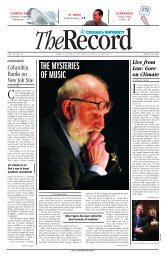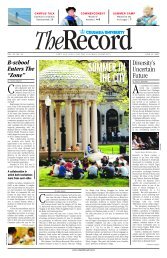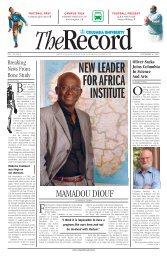January 31, 2011 - Columbia News - Columbia University
January 31, 2011 - Columbia News - Columbia University
January 31, 2011 - Columbia News - Columbia University
You also want an ePaper? Increase the reach of your titles
YUMPU automatically turns print PDFs into web optimized ePapers that Google loves.
columbia pictures <strong>January</strong> <strong>31</strong>, <strong>2011</strong> 8<br />
Diane Bondareff<br />
Thirteen winners were honored at the annual Alfred I. duPont-<strong>Columbia</strong> <strong>University</strong> Awards for excellence in broadcast<br />
journalism, which was held in Low Library on Jan. 20. Above left, CBS <strong>News</strong> correspondent Scott Pelley accepts a silver<br />
baton for “The Blowout,” an investigation into the explosion on the Deepwater Horizon oil rig in the Gulf of Mexico. At<br />
right, Brian Ross of ABC <strong>News</strong>, standing with his 20/20 producers, speaks after accepting the award for their investigation<br />
into USA Swimming’s failure to protect young female swimmers from abusive coaches. Five local television stations<br />
were also honored. And for the first time, a duPont award went to a print-based news organization, The Las Vegas Sun,<br />
for its multimedia story on gambling addiction. CNN anchor and special correspondent Soledad O’Brien and NBC anchor<br />
Lester Holt hosted the ceremony.<br />
Diane Bondareff<br />
Gene Boyars<br />
Opening with a sweep: On the first weekend of Ivy League play Jan. 15, <strong>Columbia</strong>’s men’s and women’s basketball<br />
teams beat Cornell in a Levien Gym double-header that featured a pre-game festival for <strong>University</strong> faculty and staff<br />
families to promote community attendance at women’s basketball. Two first-year players helped lead the Lions to<br />
victory. Brianna Orlich (above, left) scored a career-high 21 points in the women’s 61-54 win. Freshman guard Steve<br />
Frankowski (above, right) scored 11, including two clutch foul shots in the final minute of the men’s 79-75 conquest of<br />
last year’s Ivy champion Big Red. It was <strong>Columbia</strong>’s first win in 5 years against a Cornell program that went all the way<br />
to last year’s NCAA “Sweet Sixteen.” On <strong>January</strong> 22 in Ithaca, the men made it a sweep of their own when sophomore<br />
guard Brian Barbour (not pictured) scored a career-high 23 to lead the Lions to a 70-66 victory. The Lions’ record<br />
improved to 11-5 and 2-0 in the Ivy League; they remain on the road until meeting rivals Princeton and Penn in Levien<br />
Gym on February 11 and 12.<br />
Gene Boyars<br />
Researchers ID Bacteria<br />
continued from page 1<br />
Antarctica<br />
continued from page 1<br />
involved in vascular pathogenesis, we must be able<br />
not only to detect bacterial DNA, but first of all to<br />
isolate the bacterial strains from the vascular wall of<br />
the patient,” Kozarov said.<br />
The research team looked at five pairs of diseased<br />
and healthy arterial tissue, and found that Enterobacter<br />
hormaechei appeared in very high numbers<br />
in diseased but not in healthy arterial tissues. These<br />
bacteria, which are resistant to many antibiotics, are<br />
more often associated with the bloodstream infection<br />
sepsis as well as pneumonia.<br />
It is widely known that chronic inflammation leads<br />
to atherosclerosis. The new research suggests that the<br />
infection may start with the dissemination of bacteria<br />
though different “gates” in the vascular walls.<br />
The data also support Kozarov’s previous studies,<br />
which found periodontal bacteria in the carotid artery<br />
and implicated tissue-destroying periodontal infections<br />
in diseases of the circulatory system.<br />
According to the researchers, bacteria gain access<br />
to circulation through different avenues and then<br />
penetrate the vascular walls where they can create<br />
secondary infections that lead to atherosclerotic<br />
plaque formation.<br />
Once in circulation, Kozarov said, bacteria using<br />
this “Trojan horse” approach can persist in the organism<br />
for extended periods of time while traveling<br />
to and colonizing distant sites. This can lead to a<br />
multitude of problems including the development of<br />
atherosclerosis, which ultimately can lead to a heart<br />
attack or stroke.<br />
Dr. Jingyue Ju, director of the Center for Genome<br />
Technology & Biomolecular Engineering, and Dr. Roman<br />
Nowygrod, Department of Surgery, College of<br />
Physicians and Surgeons, also contributed to the research,<br />
which was supported in part by a grant from<br />
the National Heart, Lung, and Blood Institute of the<br />
National Institutes of Health and by the <strong>Columbia</strong><br />
<strong>University</strong> Section of Oral and Diagnostic Sciences.<br />
what are you looking at<br />
Hint: Some people think it’s a game; sometimes it’s found near troubled water. At<br />
<strong>Columbia</strong> <strong>University</strong>, doctors and medical students use it every day. What is this and on<br />
what <strong>Columbia</strong> <strong>University</strong> campus is it located Send answers to curecord@columbia.<br />
edu. The first person to email the right answer wins a Record mug.<br />
ANSWER TO LAST CHALLENGE: Ceiling relief of 3rd floor balcony in Low Library<br />
WINNER: No Winner<br />
The next 10 days are for packing, coordinating, and<br />
most important, taking safety classes of all types including<br />
the most important–a two-day/one-night class<br />
where we camp outside, learn about all the camping<br />
equipment, and show we can deal with the elements before<br />
they send us out into the unknown. We also need<br />
snowmobile school, helicopter safety school, environmental<br />
safety and awareness, crevasse training, and on<br />
and on …With all the gear and packing to put together,<br />
including food, this will take well over a week.<br />
We need to make sure we have two of many things,<br />
such as stoves, for safety. Just planning our food for<br />
when we are working takes all afternoon and half the<br />
evening.<br />
Jan. 20–We survived Happy Camper survival school!<br />
This is essential training for anyone who goes into the<br />
field on the coldest, most remote continent on Earth<br />
… We learn to build snow trenches for survival and all<br />
things related to camping in the cold, although we still<br />
appreciate that it is warmer here than back home. Also,<br />
everyone goes through snowmobile basic repair and<br />
use, rock climbing 101 and crevasse rescue training.<br />
Tomorrow is the last day before flying out to the remote<br />
CTAM (central Transantarctic Mountains) camp<br />
that we will use as a base for getting to Mount Howe<br />
and Mount Achernar. Mike Roberts, our mountaineering<br />
guide, uses the last day to give one more crevasserescue<br />
training course.<br />
We learned how to stop a fall down a steep slope,<br />
set up rescue systems and traversed around an ice fall<br />
to learn to recognize and avoid crevasses. Upon our return,<br />
we found out that our flight will be delayed a day.<br />
Very typical for Antarctica!<br />
Since the last post, the team has been at its campsite<br />
near the Transantarctic Mountains and has no access to<br />
the Internet. As of Jan. 26, they were expected to return<br />
to base camp any day. Blog posts will resume and can be<br />
found on Lamont’s website at www.ldeo.columbia.edu.






